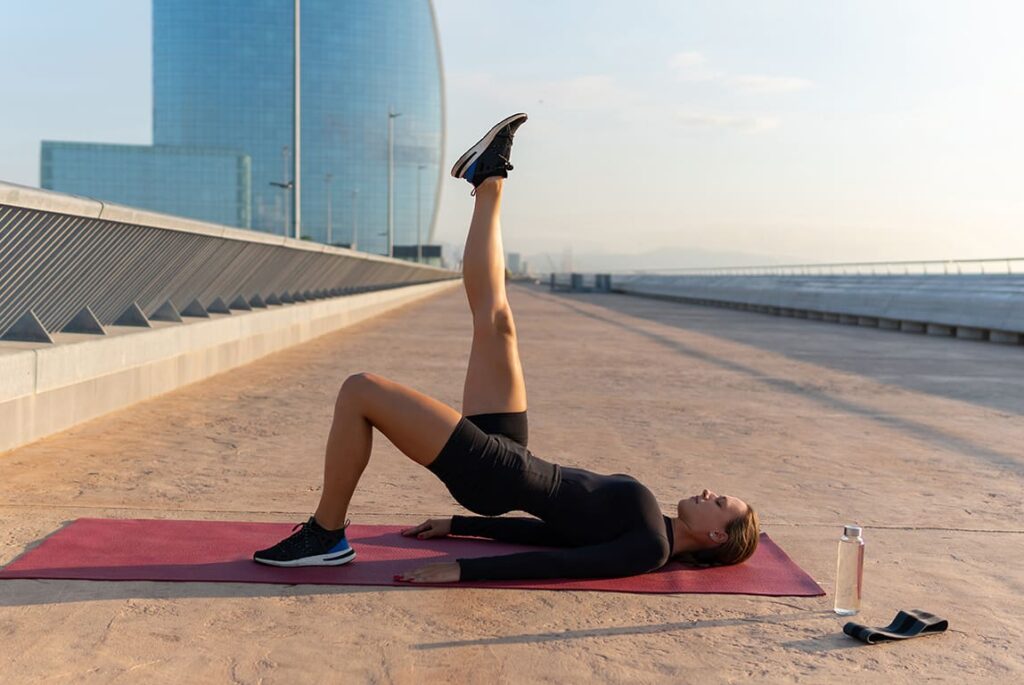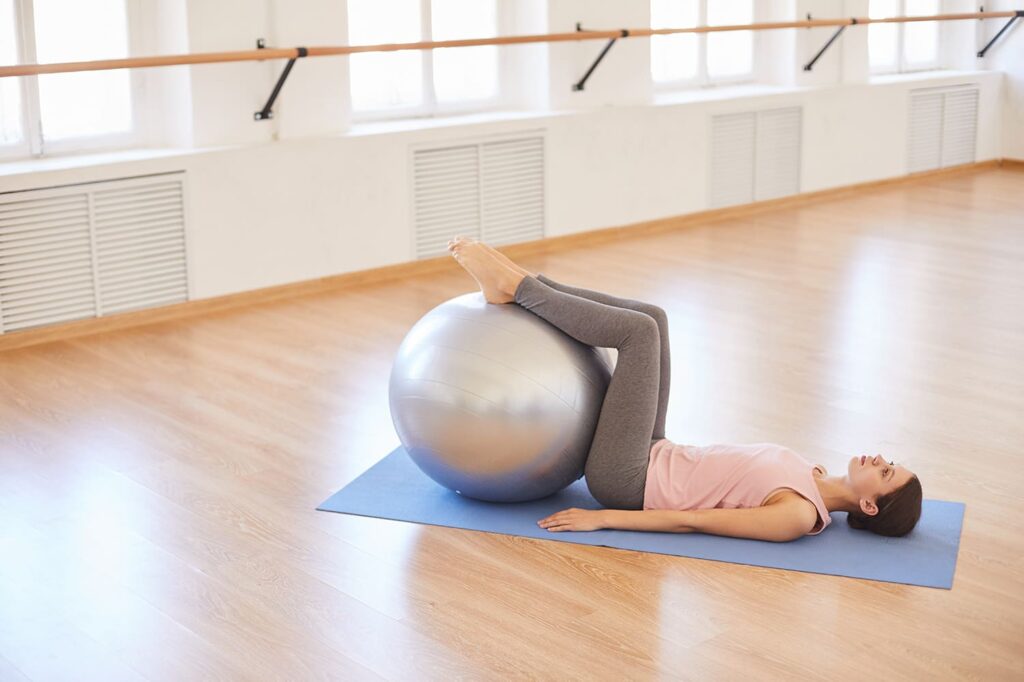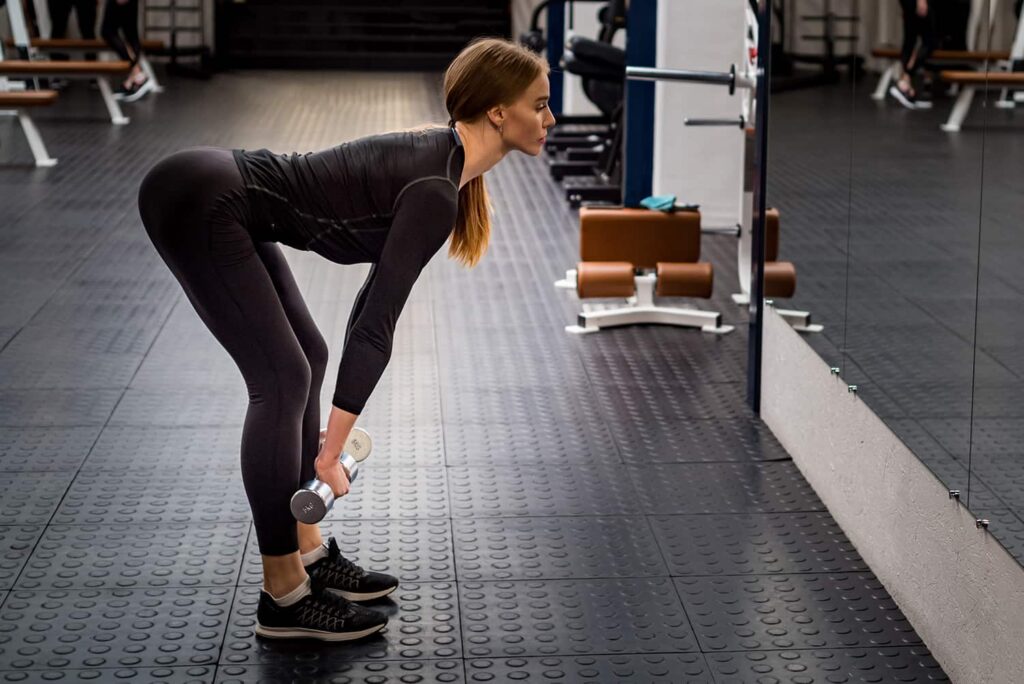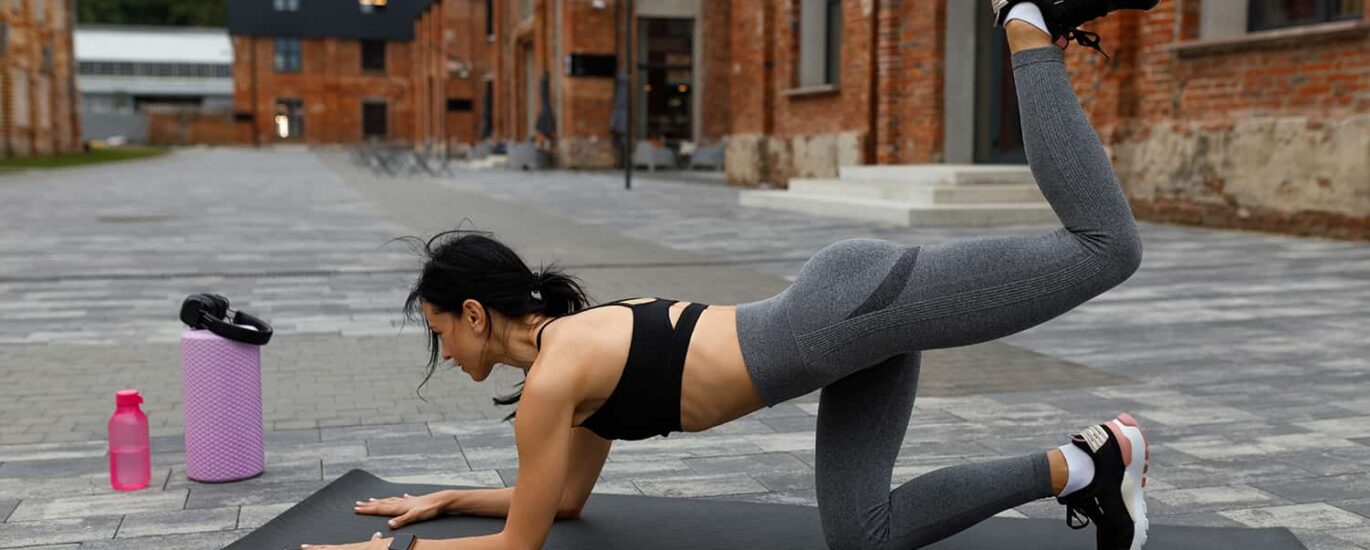STRENGTH | DEADLIFT | QUADS | SHOULDERS | BACK | ABS | BICEPS
In the bustling world we live in, it’s not always possible for everyone to make it to the gym. Whether it’s due to unexpected circumstances, busy schedules, simply your personal preference, working from home has become a more and more common option. That’s why we’re here to help you with “8 Best Hamstring Exercises at Home” – a comprehensive guide that will help you in transforming your hamstrings’ into strong, durable muscles.
You might wonder why training hamstrings are important. Well, these underappreciated muscles play a crucial role in your lower body’s function. Hamstring muscles are not important only for day-to-day activities but also for athletes trying to improve their game. Imagine having the strength to increase your squat form, run faster, or avoid accidents during everyday activities. It all starts with your hamstrings.
This article will guide you through a variety of hamstring exercises that require little to no equipment. Whether you’re an athlete, someone who wants to improve their health, or just interested in learning how to get your hamstrings into shape. , you’re at the right place.
Benefits of Strong Hamstrings
Before beginning with hamstring exercises at home, it’s very important to know why these muscles are so crucial for your health and overall fitness. Often overlooked, the hamstrings play a significant role in your daily life and athletic performance. Let’s uncover the benefits of having strong hamstrings and why you should give them priority in your training.
1. Enhanced Athletic Performance
Training hamstrings can be a game-changer for athletes of all levels. Hamstrings play a pivotal role in powering your movements, whether you’re a sprinter, a soccer player, or someone who enjoys weekend basketball games. These muscles control your hip extension and flexing your knee, essential actions in activities like running, jumping, and kicking. You’ll be more prepared to succeed in your chosen sports if your hamstrings are well-developed.
2. Injury Prevention
One of the bigger benefits of strong hamstrings is their role in injury prevention. Your lower body can become imbalanced due to weak hamstrings and can increase the risk of injuries such as tears, strains, and even knee issues. By working on hamstring strength and flexibility, your lower body can become more solid and flexible , reducing the chance of injuries during both sports and everyday activities.
3. Improved Posture and Back Health
For keeping good posture and maintaining a healthy lower back, strong hamstrings are essential. They balance out the quadriceps’ pull, which can frequently become overdeveloped. Strong hamstrings help to keep your lower back and pelvis prevented from any type of strain. This can reduce lower back pain and promote better overall posture.
4. Everyday Functionality
Your hamstrings are used in many numerous activities, From walking up stairs to picking up groceries. When these muscles are strong, you’ll find that everyday tasks become more manageable. Your daily life will be easier as you move more easily and effectively.
Warm-Up and Safety Tips
Safety and proper warm-up is very important before starting hamstring exercises at home. Neglecting these factors can lead to injuries and can create obstacles in your fitness journey. In this section, we’ll explore why warmup is important and share crucial safety tips to make sure your hamstring workouts are both efficient and injury-free
1. Warm-Up: The Foundation of Every Workout
Proper warm-up is very important before you jump into any exercise routine, whether at home or in the gym. Warming up helps to increase your heart rate, relax your muscles, and prepare your body for the upcoming physical activity. For hamstring exercises, start with five to ten minutes of light cardio, such as jogging in place or brisk walking. This helps to increase blood flow and warms up your entire body.
2. Stretching: Dynamic and Static
After your cardio warm-up, include both dynamic and static stretches to target your hamstrings. Dynamic stretches help to increase muscle elasticity and range of motion by including controlled movements, like high knees or leg swings. Follow these with static stretches, like the standing hamstring stretch, in which you hold a stretch posture for 15 to 30 seconds. Stretching helps prevent muscle stiffness and reduces the risk of strains.
3. Proper Form and Technique
Maintaining proper form during hamstring exercises is crucial for safety and effectiveness. Wrong form can strain your muscles or lead to injuries. When performing any exercise, pay close attention to your posture, spinal alignment, and the range of motion in each exercise. If you’re new to these hamstring exercises, consider seeking guidance or help from a fitness professional to ensure you’re doing it correctly.
4. Gradual Progression
When you want to see results right away, it can be tempting to push yourself to the limit. But, overexertion can lead to injuries. Instead of this, focus on gradual progression. Start with exercises that are suitable with your current fitness level, and gradually increase intensity of your workouts as you become stronger and more comfortable.
5. Listen to Your Body
One of the important safety things is to listen to your body. Pain is the signal to your body that something is wrong. If you experience any unusual pain during an exercise, stop performing that exercise immediately. Pushing through pain can lead to serious injuries, so it’s better to be cautious.
Bodyweight Hamstring Exercises At Home
Let’s begin the journey of hamstring exercises at home. In this section, we’ll explore effective bodyweight hamstring exercises that require minimal to no equipment. These exercises are perfect for those looking to develop their hamstrings without the need for gym machinery.
1. Glute Bridge

How To :
1. Perform this exercise on a comfortable surface or you can use a yoga mat.
2. Lie down on the mat with your legs extended straight ahead. Position arms at your sides, pointing toward feet, with palms facing down, alongside your torso.
3. Bend your knees and position your feet flat on the mat. Ensure that your feet are hip-width apart and facing forward.
4. Tighten your core muscles, and as you exhale, start the movement. Press through your heels to lift your hips off the ground while maintaining contact between your shoulders and feet with the floor.
5. As you reach the top of the bridge position, focus on squeezing your glutes and lifting your hips as high as your flexibility allows. In order to support your lower back, try to keep your core engaged.
6. Hold the upward position for a brief moment, focusing on the contraction in your glutes. Inhale as you prepare to lower your hips back down to the ground.
7. Slowly lower your hips back to the starting position, keeping the movement controlled and maintaining proper form.
Repetitions: Start with 12-15 repetitions of three sets.
2. Single-Leg Glute Bridge

How To :
1. This exercise is the same as above, but more effective. Perform this exercise on a comfortable surface or you can use an exercise mat.
2. Lie down on the mat with your legs extended straight ahead. Position arms at your sides, pointing toward feet, with palms facing down, alongside your torso.
3. Bend your left leg while keeping the right in an extended position. Ensure that your left foot is perpendicular to the left knee and facing forward.
4. Lift right leg upward towards the sky to get into starting position. Tighten your core muscles, and as you exhale, start the movement. Press through your left heel to lift your hips off the ground while maintaining contact between your shoulders and feet with the floor and balancing your right leg.
5. As you reach the top of the bridge position, focus on squeezing your glutes and lifting your hips as high as your flexibility allows. In order to support your lower back, try to keep your core engaged.
6. Hold the upward position for a brief moment, focusing on the contraction in your glutes. Inhale as you prepare to lower your hips back down to the ground.
7. Slowly lower your hips back to the starting position, keeping the movement controlled and maintaining proper form.
8. Same with the other side.
Repetitions: Aim for 10-12 repetitions per leg of three sets.
3. Swiss Ball Hamstring Curl

How To :
1. It’s recommended to perform this exercise in enough places and use a yoga mat.
2. Place a swiss ball near your feet. Lie on your back and place your arms to the sides of your torso.
3. Bend your knees and gently place them on a swiss ball, ensuring that your heels make contact with the ball and your toes pointing upward.
4. Exhale and begin the movement by engaging the core and lifting your hips by pushing through heels.
5. Once you reach the highest point, maintain stability and roll the swiss ball towards your hips and focus on engaging your hamstrings.
6. Inhale and slowly move the swiss ball away and bring your hips back to the floor.
Repetitions: Start with 10-12 repetitions of three sets.
4. Donkey kick

1. Begin this exercise on a comfortable mat in a tabletop position.
2. Position your bent knees directly under your hips. Ensure stability by placing your forearms on the mat, with your palms facing down and in contact with the floor.
3. Look forward to maintaining a neutral neck position. As you exhale, gradually lift your left leg, creating a 90-degree angle with the knee.
4. Engage your core muscles, focus on kicking your left foot towards the sky, reaching the highest point you can comfortably achieve.
5. At the peak of the movement, hold the position and feel the stretch in your hamstrings and hips.
6. Inhale as you gently lower your left leg back to the starting position, and then repeat the same movement with your right leg.
Repetitions: Aim for 12-15 repetitions per leg of three sets.
Dumbbell Hamstring Exercises
If you want to enhance your hamstring workout to the next level and add resistance, hamstring exercises with dumbbells are an excellent choice. Now we will explore three effective dumbbell hamstring exercises that you can easily add into your home workouts. Let’s grab dumbbells, and get started.
1. Romanian Deadlift

1. Begin this exercise by keeping a straight, upright stance while grabbing dumbbells in each hand, positioning them in front of your body.
2. Ensure that your palms are facing your body, and your feet are set shoulder-width apart for stability.
3. To maintain proper form, push your hips back, lift your chest, and move your shoulders back. Engage your core muscles and get into the starting movement by slightly bending your knees.
4. As you exhale, gradually lower your upper body by moving the dumbbells toward the floor. Keep the dumbbells close to your shins throughout this downward motion.
5. Continue lowering the dumbbells until you feel a satisfying stretch in your hamstrings.
6. Pause for a second, inhale, and smoothly raise the dumbbells back to the starting position, completing one repetition of the exercise.
Repetitions: Begin with 10-12 repetitions of three sets.
2. Dumbbell Stiff-Leg Deadlift

1. Begin by selecting two dumbbells that you can comfortably lift and hold in each hand.
2. Stand upright with your feet positioned shoulder-width apart, ensuring that your toes are pointing forward.
3. Hold the dumbbells in front of your thighs, with your palms facing your body.
4. Activate your core muscles to perform this movement. Begin by slightly bending your knees and shifting your hips backward.
5. Gradually lower the dumbbells while keeping them close to your body.
6. Continue lowering dumbbells until you feel great stretch in your hamstring muscles. It’s very important to keep your back straight during this movement.
7. When you reach the lowest position where you feel the stretch, pause for a second, and then smoothly reverse the movement.
Repetitions: Aim for 10-12 repetitions of three sets.
Combining Bodyweight and Dumbbell Exercises
Now that we’ve covered effective bodyweight and dumbbell hamstring exercises separately, it’s time to bring them together into a comprehensive workout routine. By combining these exercises, you can create a well-rounded hamstring workout that targets different aspects of muscle development and functional strength. Let’s explore two fantastic exercises that blend bodyweight and dumbbell movements.
1. Bulgarian Split Squat

1. For performing this exercise, find a bench or a surface that’s at knee height.
2. Position a table behind you and stand about 3-4 steps away from it, with your feet shoulder-width apart.
3. Lift your right leg and place it on the table behind you, ensuring that the top surface of your right foot is in contact with the table, while your other leg remains in its original position.
4. Maintain an upright chest and engage your abdominal muscles to stabilize your core.
5. Begin lowering your body by bending your left knee towards the ground.
6. Continue descending until your left thigh is parallel to the ground or your right knee nearly touches the ground.
7. Pause for a second to feel the stretch in your leg muscles.
8. Return to the starting position by pushing through your front heel.
9. Now, repeat the same movement on the other side.
Repetitions: Begin with 10-12 repetitions per leg of three sets.
2. Nordic Hamstring Curl

1. Use a yoga mat to protect your knees during this exercise.
2. You can perform this exercise with a partner providing support from behind, or you can use a barbell or dumbbells if you don’t have a partner available.
3. Begin by positioning a barbell, loaded with weights, against a wall. Lie down on the yoga mat and place your feet under the barbell.
4. Ensure that you engage your glutes, core muscles, and hamstrings throughout the entire exercise to prevent lower back injuries.
5. Inhale and gradually lower yourself toward the floor by bending your knees, keeping your hands in front for support if needed.
6. Concentrate on stretching your hamstrings as you continue moving downward.
7. Once you feel a proper stretch in your hamstring muscles, exhale and slowly return to the starting position using the same controlled movement.
Repetitions: Start with 6-8 repetitions of three sets.
Hamstring-Focused Home Workouts
Now that we’ve explored different hamstring exercises, let’s assemble them into effective home workout routines for varying fitness levels: beginner, intermediate, and advanced.
Beginner’s Hamstring Home Workout
- Warm-Up:
- light cardio of 5-10 minutes (e.g., brisk walking or jogging in place)
- Dynamic stretches (leg swings, high knees) – 5 minutes
- Exercise Routine:
- Glute Bridge – 12-15 reps of three sets
- Standing Leg Curl (Using a Chair) – 12-15 reps per leg of three sets
- Dumbbell Leg Curl – 10-12 reps of three sets
- Cool-Down:
- Static hamstring stretches – Hold each stretch for 15-30 seconds
Intermediate Hamstring Home Workout
- Warm-Up:
- 5-10 minutes of light cardio
- Dynamic stretches – 5 minutes
- Exercise Routine:
- Bulgarian Split Squat – 10-12 reps per leg of three sets
- Swiss Ball Hamstring Curl – 10-12 reps of three sets
- Romanian Deadlift – 10-12 reps of three sets
- Cool-Down:
- Static hamstring stretches – Hold each stretch for 15-30 seconds
Advanced Hamstring Home Workout
- Warm-Up:
- 5-10 minutes of light cardio
- Dynamic stretches – 5 minutes
- Exercise Routine:
- Nordic Hamstring Curl – 6-8 reps of three sets
- Bulgarian Split Squat (with added weight) – 8-10 reps per leg of four sets
- Dumbbell Stiff-Leg Deadlift – 8-10 reps of four sets
- Single-Leg Glute Bridge (with added weight) – 10-12 reps per leg of three sets
- Cool-Down:
- Static hamstring stretches – Hold each stretch for 15-30 seconds
General Workout Tips:
- Take short breaks of 60-90 seconds between sets to rest and recover.
- Always do exercises with the right form.
- Add more weight or resistance slowly when you get stronger.
- Pay attention to how your body feels, and change exercises or how many you do as necessary.
- Keep working out regularly, and remember that it takes time to see progress.
Conclusion
This was the complete at home hamstring workout. Hamstrings are a valuable part of your overall health and fitness. Remember that progress takes time, and each step forward, no matter how small, brings you closer to your goals. Stay motivated, stay consistent, and enjoy the positive changes in your body and well-being.







